7 Office Amenity Fails—and Smarter Alternatives that Boost ROI
By: David Filak
Avoiding Costly Amenity Missteps: Smarter Investments That Pay Off
Not every “shiny” amenity boosts leasing velocity or asset value, and in a market where every dollar counts, missed investments can add up fast. In this piece, we unpack seven common capital-project misfires that often look good on paper but fall flat in practice. More importantly, we share seven proven, lower-risk upgrades that today’s tenants will use, value, and are willing to pay for.
1. Dark, Unstaffed Café → Smart, Self-Serve Micro-Market
Where it Falls Short
Landlords often compete to offer tenants a food and beverage amenity, such as upscale coffee bars, hoping to energize the lobby and create a vibrant tenant experience. But without steady foot traffic or a dedicated operator to manage staffing, many of these cafés sit dark after launch, quickly turning into expensive storage space.
A Better Approach
Modular micro-markets or premium vending machines (scan-and-go fridges, bean-to-cup machines) need less than 200 SF, require no full-time staff, and can adapt to demand. Tenants still get quality snacks and coffee; landlords avoid expensive salary commitments. Just because these are simple doesn’t mean they can’t be beautifully designed as well. Focal points to lure activity into a key part of a property.
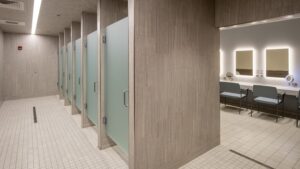
2. Boutique Fitness without Locker Rooms → Premium Private Changing Suites
Where it Falls Short
Building owners rush in bikes, treadmills, and Peloton screens but skip showers and secure lockers to save cap-ex. Tenants try the gym once, then cancel because no one wants to sweat through a 2 p.m. meeting.
A Better Approach
If space is limited, consider premium changing suites, two to three private pods with a shower and vanity, instead of a full locker room. Add towel service through a third-party provider to enhance the offering. Utilization rises, while costs stay well below a traditional build-out.
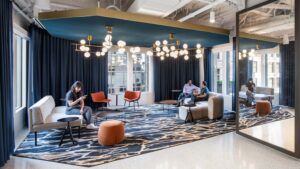
3. The Oversized, Underused Game Room → Flexible Social Hub
Where it Falls Short
Ping-pong tables and gaming lounges might sound fun, but in professional-services buildings with quieter cultures, they often go unused, and unlike flexible meeting or office space, that 1,000 SF game room doesn’t easily convert to something leasable.
A Better Approach
Design flexible social hubs: movable walls, modular lounge furniture, hidden AV. By day, it’s a breakout workspace; by evening, a tenant-event venue. If demand shifts, the zone can be downsized or monetized as a conference center space without demolition.
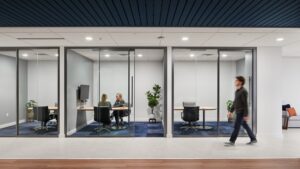
4. The Podcast Room No One Reserves → Convertible Content-Creation Nook
Where It Falls Short
Dedicated podcast booths seemed like a future-proof solution until most tenants realized they release one episode a quarter. The single-purpose build-out sits dark while meeting rooms overflow.
A Better Approach
Design a content-creation nook: acoustic panels, green screen pull-down, ring light, and detachable microphones that tuck away. In “studio” mode, it records video, audio, or webinars; in default mode, it serves as a phone or two-top Zoom room.
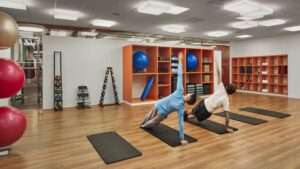
5. Indoor Putting Green → Multi-Purpose Wellness Studio
Where It Falls Short
A synthetic turf putting strip looks clever on a tour, but usage data shows fewer than 5% of employees practice putts at work. Worse, the turf can’t convert to another function without full replacement.
A Better Approach
Create an 800-SF wellness studio featuring a rubberized floor, mirrored walls, and flexible storage for yoga mats, barre bars, and guided meditation setups. Programming can adapt to tenant needs, whether it’s a sunrise stretch, lunchtime HIIT, or after-hours mindfulness session, driving high utilization with minimal renovation risk.
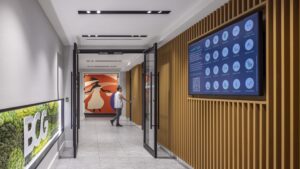
6. Over-Engineered Building App → QR-Based Amenity Booking & Wayfinding
Where It Falls Short
Custom property apps often come with six-figure price tags and ongoing maintenance, but rarely deliver. With adoption rates typically under 25%, most tenants still rely on email or Slack to book space.
A Better Approach
Deploy QR code touch points at amenity entrances: scan to reserve a meditation pod, order coffee, or get wayfinding to the bike storage. No downloads, minimal upkeep, and analytics feed landlord asset dashboards.
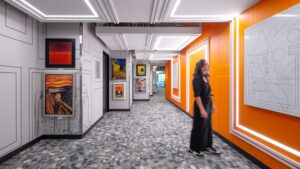
7. Lobby Water Feature → Living Digital Art Wall
Where It Falls Short
Fountains and reflecting pools leak, add slip hazards, and send common-area utility costs up (pumps, water loss). They’re also impossible to repurpose.
A Better Approach
Mount a high-resolution LED art wall that showcases local artists, data-driven generative art, or tenant-brand takeovers. Zero plumbing, easy content refresh, and sponsors can underwrite segments, turning an expense into marketing revenue.
Ready to Audit Your Amenity Strategy?
In today’s market, amenities must do more than look good; they need to meet evolving tenant expectations and deliver strong ROI. NELSON’s Asset Strategy team is here to help you make smarter, data-informed decisions about where to invest for maximum return and where to rethink. Let’s talk about how to align your amenities with real market demand and measurable value.

David Filak, Associate Principal | Senior Studio Leader | Business Development Leader, Asset Strategy
David is a dynamic and motivated professional with a talent for generating and building relationships. His experience as a professional athlete has offered an inside look at what makes for a successful team. David leverages this experience by learning the goals and drivers of a project, designing educational and delivery strategies, and coaching individuals towards success. He is an adaptable leader with the ability to promote enthusiasm in the workplace and on project teams. David is an active member of the BOMA ELC: Emerging leaders program. Reach out to him at DFilak@nelsonww.com